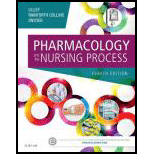
To define:
The normal anatomy, physiology, and function of the skin.
Concept introduction:
The largest organ present in the body is the skin that is involved in several functions and mainly covers the whole body. The skin is involved in sensation, protection, excretion, and absorption, regulation of temperature, and
Explanation of Solution
The anatomy and physiology of the skin:
The skin is made up of two layers that include the outer layer, which is called epidermis and the innermost layer, which is called dermis. The epidermis is composed of four layers such as stratum corneum, stratum licidum, stratum granulosum, and stratum germinativum. The epidermis gives the tone for the skin and also provides a waterproof barrier.
- Stratum corneum: It is the outermost layer that contains dead cells called keratinocytes and it is converted into keratin protein. It is the protective layer for the skin.
- Stratum licidum: It is translucent and visible only in the thick skin that contains flat cells.
- Stratum granulosum: It is the middle layer of the epidermis and it is otherwise called granular layer. It is involved in the waterproofing function.
- Stratum germinativum: This layer is involved in producing melanin and pigment for the skin.
The dermis is present below the epidermis that contains hair follicles, sweat glands, and connective tissue. Beneath the dermis, deeper subcutaneous fatty tissue or hypodermis is present that is made of connective and fat tissues. The dermis differs from the epidermis in several ways and it is rich in providing nerves, elastic tissue, connective tissue, vessels, and lymphatic tissue. The dermis also contains exocrine glands that include eccrine, apocrine, and sebaceous glands.
Sebaceous gland: It contains lipid cells, which produce the oil that protects the skin.
Eccrine gland: The eccrine glands are sweat glands that are present throughout the skin. It helps to avoid the dryness of the skin and regulate the temperature of the body.
Apocrine gland: It is mainly present in the area of the breast, genital organs, and axilla. These apocrine glands produce odor.
The function of the skin:
- The important function of the skin is protected from the external agents that include microorganism and chemicals.
- Maintains the pH of the skin from 4.5 to 5.5.
- The skin also has the ability to feel the temperature, pain, and pressure.
- The skin has the ability to excrete the electrolyte and fluid.
- It also synthesizes vitamin D and stores fat.
The skin is the most important organ and it is involved in several functions, and the key role of the skin is to protect the body from severe water loss and pathogens.
Want to see more full solutions like this?
Chapter 56 Solutions
Pharmacology and the Nursing Process, 8e
 Phlebotomy EssentialsNursingISBN:9781451194524Author:Ruth McCall, Cathee M. Tankersley MT(ASCP)Publisher:JONES+BARTLETT PUBLISHERS, INC.
Phlebotomy EssentialsNursingISBN:9781451194524Author:Ruth McCall, Cathee M. Tankersley MT(ASCP)Publisher:JONES+BARTLETT PUBLISHERS, INC. Gould's Pathophysiology for the Health Profession...NursingISBN:9780323414425Author:Robert J Hubert BSPublisher:Saunders
Gould's Pathophysiology for the Health Profession...NursingISBN:9780323414425Author:Robert J Hubert BSPublisher:Saunders Fundamentals Of NursingNursingISBN:9781496362179Author:Taylor, Carol (carol R.), LYNN, Pamela (pamela Barbara), Bartlett, Jennifer L.Publisher:Wolters Kluwer,
Fundamentals Of NursingNursingISBN:9781496362179Author:Taylor, Carol (carol R.), LYNN, Pamela (pamela Barbara), Bartlett, Jennifer L.Publisher:Wolters Kluwer, Fundamentals of Nursing, 9eNursingISBN:9780323327404Author:Patricia A. Potter RN MSN PhD FAAN, Anne Griffin Perry RN EdD FAAN, Patricia Stockert RN BSN MS PhD, Amy Hall RN BSN MS PhD CNEPublisher:Elsevier Science
Fundamentals of Nursing, 9eNursingISBN:9780323327404Author:Patricia A. Potter RN MSN PhD FAAN, Anne Griffin Perry RN EdD FAAN, Patricia Stockert RN BSN MS PhD, Amy Hall RN BSN MS PhD CNEPublisher:Elsevier Science Study Guide for Gould's Pathophysiology for the H...NursingISBN:9780323414142Author:Hubert BS, Robert J; VanMeter PhD, Karin C.Publisher:Saunders
Study Guide for Gould's Pathophysiology for the H...NursingISBN:9780323414142Author:Hubert BS, Robert J; VanMeter PhD, Karin C.Publisher:Saunders Issues and Ethics in the Helping Professions (Min...NursingISBN:9781337406291Author:Gerald Corey, Marianne Schneider Corey, Cindy CoreyPublisher:Cengage Learning
Issues and Ethics in the Helping Professions (Min...NursingISBN:9781337406291Author:Gerald Corey, Marianne Schneider Corey, Cindy CoreyPublisher:Cengage Learning





